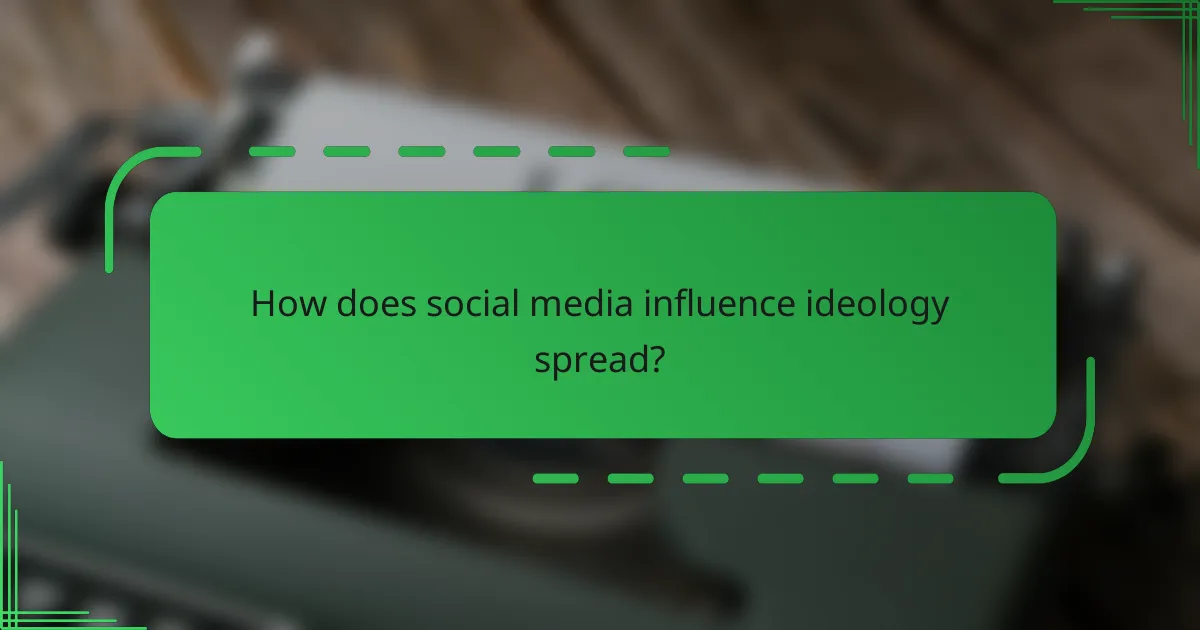Social media plays a crucial role in the dissemination of ideology, facilitating swift communication and engagement among users. By providing a platform for diverse beliefs to be showcased, it often elevates fringe ideas that might otherwise go unnoticed. The unique structures of various social media platforms further influence how information is shared and consumed, shaping user interactions and potentially leading to echo chambers or vibrant discussions.

How does social media influence ideology spread?
Social media significantly influences the spread of ideology by enabling rapid communication and engagement among users. This platform allows diverse beliefs to gain visibility, often amplifying fringe ideas that might otherwise remain obscure.
Amplification of fringe beliefs
Fringe beliefs can gain traction on social media due to the platform’s ability to connect like-minded individuals. Users often seek out content that aligns with their views, leading to echo chambers where unconventional ideas are reinforced and normalized.
This amplification can result in the mainstreaming of previously marginalized ideologies, as users share and promote content that resonates with their beliefs. As a result, these ideas may influence broader public discourse and even policy discussions.
Rapid dissemination of information
Social media facilitates the quick spread of information, allowing ideologies to reach large audiences almost instantaneously. This rapid dissemination can lead to viral trends, where specific beliefs or narratives gain popularity in a matter of hours or days.
However, the speed of information sharing can also lead to misinformation, as users may not verify the accuracy of the content before sharing. This underscores the importance of critical thinking and fact-checking in the digital age.
Role of algorithms in shaping narratives
Algorithms play a crucial role in determining which content users see on social media platforms. These algorithms often prioritize engagement, promoting posts that generate likes, shares, and comments, which can skew visibility toward sensational or polarizing content.
As a result, users may be exposed to a narrow range of ideologies that align with their previous interactions, reinforcing existing beliefs. Understanding how these algorithms work can help users navigate social media more effectively and seek out diverse perspectives.

What are effective strategies for engagement on social media?
Effective strategies for engagement on social media include creating interactive content, fostering community dialogue, and leveraging influencer partnerships. These approaches can significantly enhance user interaction and strengthen brand loyalty.
Utilizing interactive content
Interactive content, such as polls, quizzes, and live videos, encourages users to participate actively rather than passively consuming information. This type of content can increase engagement rates by making users feel involved and valued.
Consider incorporating tools like Instagram Stories or Facebook Live to create real-time interactions. Aim for a mix of content types to keep your audience engaged, with interactive posts comprising around 20-30% of your overall content strategy.
Building community through dialogue
Fostering dialogue within your social media channels helps build a sense of community among followers. Responding to comments, asking questions, and encouraging discussions can create a more personal connection with your audience.
To facilitate meaningful conversations, set aside time daily to engage with followers. Use open-ended questions to prompt responses and consider hosting regular Q&A sessions to address audience interests directly.
Leveraging influencer partnerships
Partnering with influencers can amplify your reach and credibility on social media. Influencers often have established trust with their followers, making their endorsements valuable for promoting your brand.
When selecting influencers, consider their audience demographics and engagement rates to ensure alignment with your target market. Aim for partnerships that feel authentic and relevant to your brand, and consider micro-influencers for more niche engagement, as they often have higher engagement rates compared to larger accounts.

How do different platforms affect ideology spread?
Different social media platforms influence the spread of ideology through their unique structures and user interactions. Each platform shapes how information is consumed and shared, impacting engagement and the formation of echo chambers or diverse discussions.
Facebook’s echo chamber effect
Facebook often creates echo chambers where users are exposed primarily to viewpoints that align with their own beliefs. This occurs due to algorithms that prioritize content from friends and groups that share similar ideologies, reinforcing existing opinions.
To navigate this effect, users should actively seek diverse perspectives by following a variety of pages and engaging with differing viewpoints. This can help mitigate the risk of becoming trapped in a single ideological bubble.
Twitter’s real-time discourse
Twitter facilitates real-time discussions, allowing ideologies to spread rapidly through trending topics and hashtags. The platform’s character limit encourages concise expressions of thought, which can lead to both quick engagement and oversimplification of complex issues.
Users can enhance their understanding by participating in conversations and following threads that explore various angles of a topic. However, it’s crucial to verify information before sharing, as misinformation can spread just as quickly.
Instagram’s visual storytelling
Instagram utilizes visual content to convey messages, making it a powerful tool for ideology spread through imagery and short videos. The platform’s emphasis on aesthetics can attract attention but may also obscure deeper discussions about the issues being represented.
To effectively engage with ideological content on Instagram, users should consider the context behind images and seek out captions or stories that provide more in-depth information. Engaging with diverse accounts can also broaden one’s perspective on various issues.

What metrics measure social media influence?
Social media influence is primarily measured through metrics that evaluate user engagement, brand visibility, and audience sentiment. Key metrics include engagement rates, share of voice, and sentiment analysis, each providing insights into how effectively content resonates with audiences.
Engagement rates
Engagement rates reflect how actively users interact with content on social media platforms. This includes likes, shares, comments, and overall interactions relative to the number of followers or impressions. A typical engagement rate can range from 1% to 5%, with higher rates indicating stronger audience interest.
To calculate engagement rates, divide the total interactions by the total reach or impressions, then multiply by 100. Monitoring these rates helps brands assess which content types generate the most interaction and adjust their strategies accordingly.
Share of voice
Share of voice measures a brand’s presence in conversations compared to competitors within a specific market or topic. This metric is expressed as a percentage, indicating how much of the total mentions or discussions a brand captures. A higher share of voice suggests greater brand visibility and influence.
To calculate share of voice, track mentions across social media platforms and divide your brand’s mentions by the total mentions of all competitors. This metric is crucial for understanding market positioning and identifying areas for improvement in brand communication.
Sentiment analysis
Sentiment analysis evaluates the emotional tone behind social media mentions, categorizing them as positive, negative, or neutral. This metric provides insight into public perception and can guide content strategies and customer engagement efforts. Tools for sentiment analysis often use natural language processing to assess large volumes of data.
Understanding sentiment can help brands identify potential issues or opportunities in their messaging. Regularly monitoring sentiment trends allows for timely adjustments to marketing strategies, ensuring alignment with audience expectations and feelings.

What are the ethical considerations in social media influence?
Ethical considerations in social media influence revolve around the impact of content on public perception, privacy issues, and the responsibility of influencers. Understanding these factors is crucial for both users and creators in navigating the digital landscape responsibly.
Manipulation of public opinion
Social media platforms can significantly shape public opinion through targeted content and algorithms that prioritize certain narratives. This manipulation often occurs without users’ awareness, leading to biased perspectives and polarized views. For example, algorithms may amplify sensationalist content, influencing users’ beliefs and behaviors based on skewed information.
To mitigate manipulation, users should critically evaluate sources and seek diverse viewpoints. Engaging with a variety of content can help counteract the effects of algorithmic bias, fostering a more balanced understanding of issues.
Privacy concerns
Privacy is a major ethical consideration in social media influence, as personal data is often collected and used without explicit consent. Users may unknowingly share sensitive information, which can be exploited for targeted advertising or even political campaigning. Regulations like the General Data Protection Regulation (GDPR) in Europe aim to protect users, but many still remain unaware of their rights.
To protect privacy, users should regularly review privacy settings and be cautious about the information they share. Utilizing privacy-focused tools and platforms can also help safeguard personal data from misuse.
Accountability of influencers
Influencers hold significant power in shaping opinions and trends, which raises questions about their accountability for the content they promote. Misleading endorsements or unverified claims can lead to misinformation and harm to followers. Ethical influencers should disclose partnerships and ensure transparency in their communications.
Consumers should be discerning when following influencers, looking for those who prioritize honesty and integrity. Checking for disclosures and researching claims can help followers make informed decisions about the content they consume.



